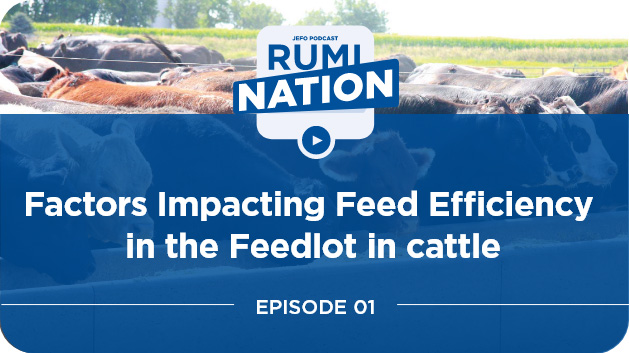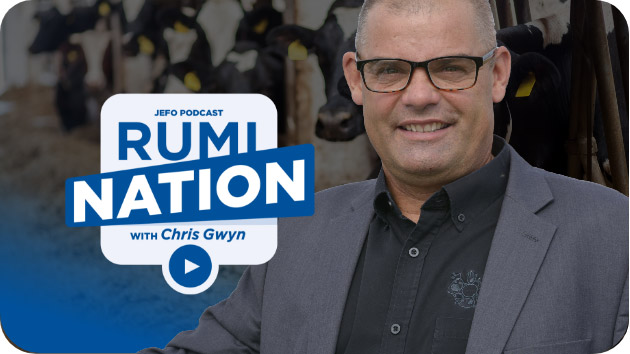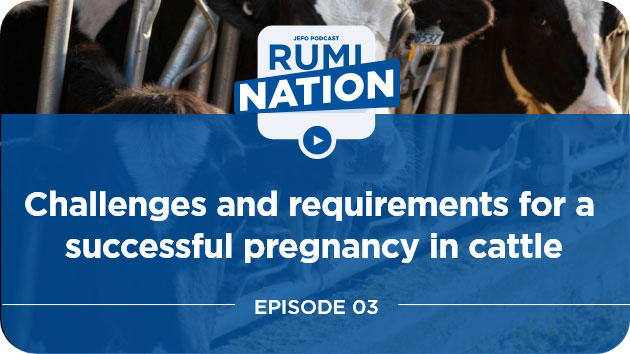RumiNation | S04 : E02
Reproductive Health and Management in Postpartum Cow
Brought to you by Jefo Nutrition
Share now!
Did you enjoy this episode?
Share now!
Our guest - Dr. Stephen LeBlanc
Dr. LeBlanc is a veterinarian and professor working in dairy cattle health management. He received a BSc (Agr) in Animal Science from McGill University in 1992, and later a DVM (in 1997) and DVSc (in 2001) from the University of Guelph. After five years of private practice in veterinary medicine, he joined the faculty at OVC. His research focus is dairy cattle health and performance. His most significant contributions have been in the area of dairy cattle reproduction, specifically in improving reproductive performance through better prevention and treatment of reproductive disease and development of reproductive management programs.

Contact
Join the Rumination community
Timestamps & Summary
2:10
Postpartum, uterine health, inflammation, immunity, impact on reproduction; what is it about this area that really intrigued you?
Dr. Stephen LeBlanc
Well, I think it is a really interesting scientific challenge. There are a lot of complexity and interest here. But more to the point, it looks to be something that has got some real practical importance. We know that calving is an inflammatory event. So, the birthing process involves setting off a bunch of inflammatory processes and cascades. And even in the best-case scenario, there is going to be some tissue trauma and some bacterial contamination of the reproductive tract after calving. And so, the cow has to respond to that. Part of that is an immune and inflammatory response to repair tissue damage, to clear up some of these bacterial contaminants and keep the load of potential pathogens in check. […]
5:06
Tell us about how well we are capturing the information and awareness of these reproductive challenges post calving.
Dr. Stephen LeBlanc
Maybe not well enough. Let us go with Metritis. That is a cow first week postpartum, a sick cow, the cardinal sign is that she smells really bad at discharge from some barnyard microbiology. That tells us that she has got an infection with anaerobic bacteria. That is what makes it smell bad. So, you are not likely to miss those as a producer. But interestingly, even if we say that that’s the case definition, if detection is a little bit passive -you notice the cow when she comes in the parlor, or when you’re walking the pen, as opposed to, if you’re locking the fresh cows up every day or every other day, and really proactively going hunting. On one end, you might say, I have got 5% of my cows that have Metritis. With the same definition, you could easily say I have 20% of my cows that have Metritis. And I do not know which one is actually the better approach; one is probably under diagnosing, and one might be over diagnosing if you’re doing that every day […]
9:38
You recently published a review on the relationship between metabolism, immunity, and the neutrophil function. Could you summarize some of the key points of that review and how it relates to fresh cow health and reproduction?
Dr. Stephen LeBlanc
By far, the number one line of defense are neutrophils. They are like the first responders. They are like little Pac-Man, and they will go around and gobble up bacteria, or even bits of dead tissue that are not normal. And probably the first big thing is that there should be enough of them, and that they get there quickly enough and in sufficient numbers and get the job done. And so that involves, again, generally feeding the immune system, because there’s lots of work that shows that those first responders require a lot of nutrient inputs: energy, antioxidants, vitamins, and minerals, etc. We know from some of the work done at Iowa State and elsewhere now as well, that that is a very energy, intense process, you know, how much glucose is needed, how much calcium is needed, as well, for neutrophils to do its thing. And so again, we can add that robust, yet regulated immune response to the list of other reasons why we really got to try to dial in nutrition and management.
Last but not least, the part that we understand a lot less about is sort of the back side of that response curve. We are focused a lot on the response time, are the first responders sufficient? Sufficiently fast? Sufficiently well equipped? And so on. And clearly that has got to come first. But when we get thinking about chronic smoldering, reproductive tract inflammation in the Metritis, that probably has a lot more to do with how effectively that dial is turned back down again, in the days or weeks once that initial response is over. And that is a really hot area of research and we’re just scratching the surface of with cows.
13:38
Do you want to expand a bit on that? They have this response, but then they come back to normal quickly.
Dr. Stephen LeBlanc
Exactly. We think that if you could draw a visual of healthy neutrophil response or immune and inflammatory response, it would happen very quickly, sort of hours to a day or two after calving. So, accelerate very quickly, probably hit its peak, in days or within a few days after calving and get the job done. The uterus is not sterile but reduce the level of pathogens back down to a very low kind of background level, deal with the tissue trauma, help initiate healing, regrowing a new epithelium so that over weeks that the cow is ready and able to be pregnant again. That should all happen in days to a couple of weeks. And then that inflammatory state is dialed back down not to zero but to kind of a low baseline level and we think that is by about three weeks postpartum in a healthy cow. […]
19:27
We did not really talk about the numbers, but the impact of poor uterine health on reproduction is pretty significant.
Dr. Stephen LeBlanc
Yes, absolutely. So, just to put it in pragmatic terms, for cows that have, or live through, any of Metritis, endometritis, purulent vaginal discharge a month postpartum, we are talking 20 to 30 plus extra days open, and 20% more cows that will fail to get pregnant by 250-300 days in milk by which point, it’s too late. This is a meaningful problem. And again, at that prevalence of one in five, one in four cows, that can certainly start to become a meaningful thing, not just for a few exceptions, but actually a meaningful slice of a herd.
20:32
Just to summarize. If we were talking to the dairy producer, nutritionists today and reminded the importance of improving uterine health, you want to just highlight a few of the key things that you feel are really important to remind ourselves on?
Dr. Stephen LeBlanc
Yes, and again, no marks for originality here. But I do think it really does come back to some of those really fundamentally important things. So, what does that mean? Right up near the top of my list would be sufficient space for feeding and lying for transition cows. So, although the evidence base is not as big as we might like it to be, having no more than 4 cows for five headlocks, or at least 30 inches of bunk space per cow. A little bit more cows than stalls and or 120-130 square feet of lying space on a pack situation for, for transition cows, abundant water, so two sources per pen, ten centimeters of linear trough space per cow, again, no marks for creativity on any of this stuff. Heat abatement for not only for fresh cows, but also for close up cows again. You know, sometimes producers are like “Yeah, I heard all that. But you know, and I am only doing part of it, because life is difficult. And, you know, it is complicated. But, you know, what else can I do?” Well, I get it, the whole art of farming is figuring out how to get as close as possible to doing those things. But really, if you can get those things done and find creative ways to do that, you are really kind of cooking with gas. And conversely, if you cannot, boy, you’re fighting with one arm behind your back, or to mix metaphors, you’re pushing water uphill a bit. So yes, I think those are the things that tomorrow can really help to support uterine health via good immune response and well-regulated inflammation.
Need more information?









